History
Lighthouse Construction
Construction started on Plum Beach Lighthouse in 1896. It was built using a pneumatic caisson. The lighthouse’s foundation was built on shore and towed to its present location and sunk to the bottom. Once the foundation settled on the bottom, the water was pumped out and filled with air. Workers went into it and dug the dirt at the bottom of the foundation. As they removed the dirt, the foundation sunk lower in to river bottom. A core sample taken during construction discovered a seven-foot layer of quicksand at the depth the foundation was going to bottom out. Construction was stopped because the foundation had to be heightened to get past the quicksand. This required additional funding. The foundation was covered with a wooden peaked roof. A red light was placed on the unfinished foundation in 1897. Congress appropriated $9,000 in 1898 to finish it. Work was restarted in April 1899 and was finished in June 1899. It was first lighted on July 1, 1898.
Abandonment and declining condition
The Jamestown Bridge was completed in 1940, and the lighthouse soon became obsolete. In 1941, The Coast Guard officially extinguished the light on 1 May 1941. Shortly after the lighthouse was put up for bid, with the Coast Guard giving preference to those willing to demolish or move the lighthouse within 90 days. When no bids were offered, the structure was abandoned. During the following period of disuse, the lighthouse's windows and doors disappeared, and pigeons claimed it as their home. Soon, a thick layer of guano covered the floors of the lighthouse, and was no longer safe for unprotected human contact. In 1971 and 1972, a University of Rhode Island professor and graduate student began making weekly visits to the lighthouse to conduct studies on the pigeons. To protect themselves from the guano, the URI experimenters wore masks and other protective clothing. In 1971, the professor and student discovered a natural population control system used by the pigeons, in which the birds abandoned approximately 40% of their eggs each year to keep the number of births each year nearly the same. The next year, the researchers removed 20% of the eggs, and the pigeons compensated by abandoning many fewer eggs.
Painting efforts and lawsuit
Little was done to protect the lighthouse until the mid 1970s when an attempt was made to paint the structure. Because of the amount of bird droppings in the building, the painting effort ceased after one of the workers became ill from the effects of the guano. After years of ownership squabbles between the Coast Guard and the State of Rhode Island, with neither side wanting to cover the maintenance costs, the dispute was finally settled when James Osborn, a painter who had worked at the lighthouse in the 1970s, sued the state in 1984 for $500,000 as compensation for a rare disease called histoplasmosis he contracted from all the dried guano in the lighthouse. In 1998, after much time the case spent bouncing back and forth between Rhode Island's Supreme and Superior Courts, the courts decided the state owned the structure, and the state paid Osborn $42,000 three months later.
Private ownership and restoration
In 1988, a private company attempted to purchase the lighthouse and move it to a Quincy, Massachusetts, condominium development, where they would convert it to a lighthouse history museum. When this plan was made public, Portsmouth, Rhode Island resident Shirley Silvia, organized the Friends of Plum Beach Lighthouse, a nonprofit organization, with the purpose of purchasing the lighthouse, restoring it, and preserving it in its original condition and location. However, neither group was able to buy the structure due to the disputed ownership which had not yet been decided by courts. When the State of Rhode Island was given the deed to the property in 1999, they gave ownership to the Friends of Plum Beach Lighthouse. In a ceremony held at Plum Beach, the Friends' President and founder Shirley Silvia accepted the deed from DEM Director Jan Reitsma. Also in attendance were board members Dot and George Silva, and Friends vice-president Alda Kaye. In the same year, the Friends received a $500,000 grant to restore the tower under the Transportation Act for the 21st Century. In 2000, after visiting the site, the Newport Collaborative Architects gave an estimate of $955,000 to restore the entire exterior and interior of the lighthouse.
In October 2009, the Friends of Plum Beach Lighthouse received approval to offer license plates featuring an image of the lighthouse. Proceeds from the sale of the plates would be used to maintain the lighthouse, but an initial order of 900 plates was required. The Friends were able to surpass the minimum order in just eight weeks of sales, and since then over 10,000 have been sold. Revenue from the plates was used to repaint the lighthouse in 2010 and 2017.
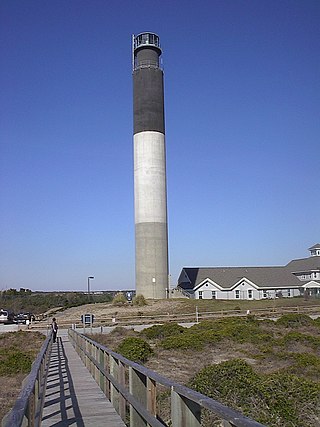
The Oak Island Lighthouse is located in the Town of Caswell Beach near the mouth of the Cape Fear River in Southeastern North Carolina. It sits next to the Oak Island Coast Guard Station on the east end of Oak Island in Brunswick County looking south out at the Atlantic Ocean. Featuring 16 LED lights which produce four, one-second bursts of light every 10 seconds, it has a luminous range of 20.5 nautical miles. Owned by the town since 2004, it is managed by a citizens group.

Butler Flats Light is a sparkplug lighthouse located in the outer harbor of New Bedford, Massachusetts, at the mouth of the Acushnet River. Built in 1898 by the United States Lighthouse Board, it is the only known caisson lighthouse designed by a marine architect. The light was added to the National Register of Historic Places as Butler Flats Light Station on June 15, 1987. Automated in 1978, it is now operated by the city as a private aid to navigation.

The Baltimore Harbor Light, officially Baltimore Light and historically Baltimore Harbor Lighthouse is a privately owned caisson lighthouse in the Chesapeake Bay in Maryland. First lit in 1908, it sits at the mouth of the Magothy River, marking the channel which leads northwest to the opening of the Patapsco River, which then leads into the Baltimore harbor. The light is located adjacent to the mouth of the Magothy River. At the time of its construction, it was the world's tallest caisson lighthouse due to the deep sediment of its location. It was the world's first nuclear powered lighthouse for a brief time in the 1960s.
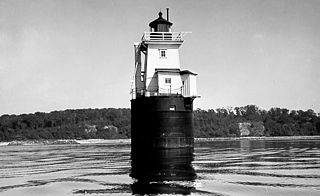
Cold Spring Harbor Light was a lighthouse located in Cold Spring Harbor on the north shore of New York's Long Island. It was built in 1890 to mark a shoal at the entrance to Cold Spring Harbor. After the lighthouse was deactivated in 1965, the original light and tower were purchased by a private individual and moved to its current location on land, one mile (1.6 km) to the southwest. An automated light tower and day beacon were erected on the original caisson, and continue to serve as a navigation aid.

Point No Point Light, located in the Chesapeake Bay off the eponymous point several miles north of the mouth of the Potomac River, was constructed as part of a program to add lighted navigational aids in a thirty-mile stretch of the bay between Cove and Smith Points.

The Harbor of Refuge Light is a lighthouse built on the ocean end of the outer Delaware Breakwater at the mouth of the Delaware Bay, just off Cape Henlopen. It was built to function with the Delaware Breakwater East End Light in order to mark the National Harbor of Refuge.

Orient Point Light is a sparkplug lighthouse off Orient Point, New York in Plum Gut of Long Island Sound – the deep and narrow gap between Orient Point and Plum Island. It was built in 1899 and was automated in 1954. The lighthouse was listed on the National Register of Historic Places in 2007.

Great Captain Island Lighthouse is a lighthouse on Great Captain Island in the western Long Island Sound off the coast of Greenwich, Connecticut, United States. Built in 1829, the first lighthouse, made of stone, was of such poor construction that the walls were severely cracked a decade later. In 1868, a new granite dwelling with attached lantern was completed. The lighthouse is of the same design as lighthouses at Sheffield Island in Norwalk; Morgan Point in Noank; Old Field Point Light and Plum Island in New York; and Block Island North in Rhode Island. In 1890, a fog whistle was added, in 1905 a siren was installed. The lighthouse was deactivated in 1970 when a skeletal tower replaced it. The Town of Greenwich acquired the property in 1973 and had full-time caretakers on the site until the lighthouse became too dilapidated in 2003. A successful restoration effort was completed in 2009 and a non-navigational light was activated in 2012. In 2010, a memorial plaque was installed to "honor the 23 people who lived in Greenwich, or had a connection to the town", who died in the September 11, 2001 attacks. In 1991, the Great Captain Island Light was added to the National Register of Historic Places.

Greens Ledge Lighthouse is a historic offshore lighthouse in the western Long Island Sound near Norwalk, Connecticut and Darien, Connecticut. It is one of 33 sparkplug lighthouses still in existence in the United States and remains an active aid to navigation. It sits in ten feet of water on the west end of Greens Ledge, a shallow underwater reef that runs a mile west of Sheffield Island and is roughly a mile south of the entrance to Five Mile River at Rowayton. Completed in 1902 by the Philadelphia Construction Company, the cast-iron structure is approximately 90 feet tall including roughly 15 feet of the submerged caisson. In 1933, more than 30,000 tons of rocks from the excavation of Radio City Music Hall were added to the riprap foundation. The light was added to the National Register of Historic Places as Greens Ledge Lighthouse on May 29, 1990.
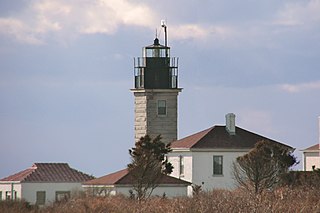
Beavertail Lighthouse was built in 1856 and is the premier lighthouse in Rhode Island, marking the entrance to Narragansett Bay. The 64-foot (20 m) lighthouse lies on the southernmost point of Conanicut Island in the town of Jamestown, Rhode Island in Beavertail State Park, on a site where beacons have stood since the early 18th century. The light provides navigation for boats and ships entering Narragansett Bay in the East Passage between Conanicut Island and Newport, Rhode Island on Aquidneck Island. Other lighthouses are visible from Beavertail Lighthouse, such as Castle Hill Lighthouse, Point Judith Light, and Rose Island Light.

Solomons Lump Light is a lighthouse in the Chesapeake Bay, the abbreviated remains of a caisson light built in 1895. That structure replaced a screw-pile light built on the same spot in 1875, which in turn superseded the Fog Point Light.

The Hooper Island Light is a lighthouse in the Chesapeake Bay, west of Middle Hooper Island in Maryland.

Wolf Trap Light is a caisson lighthouse in the Virginia portion of the Chesapeake Bay, about seven and a half miles northeast of New Point Comfort Light. It is listed on the National Register of Historic Places.

The Harbor Beach Lighthouse is a "sparkplug lighthouse" located at the end of the north breakwall entrance to the harbor of refuge on Lake Huron. The breakwall and light were created by the United States Army Corps of Engineers to protect the harbor of Harbor Beach, Michigan, which is the largest man-made freshwater harbor in the world. Harbor Beach is located on the eastern edge of the Thumb of Huron County, in the state of Michigan.
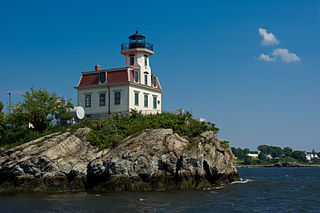
Pomham Rocks Light is a historic lighthouse in the Providence River about 200 yards (180 m) off the shoreline of the Riverside neighborhood of the city of East Providence, Rhode Island. It is the northernmost lighthouse in Narragansett Bay.
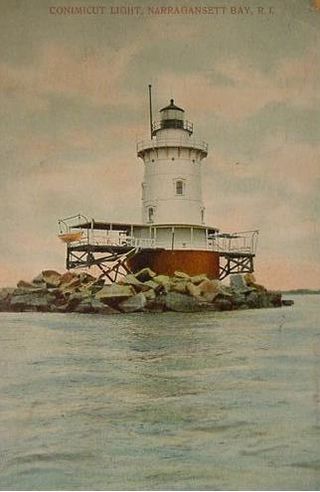
Conimicut Light, built in 1883, is a historic sparkplug lighthouse in Warwick, Rhode Island. The lighthouse was listed on the National Register of Historic Places in 1988. The lighthouse is said to be in "relatively good condition."
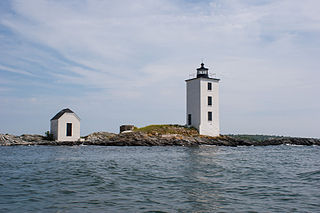
Dutch Island Light is a historic lighthouse on Dutch Island off Jamestown, Rhode Island.

Plum Island Light is located on the western end of Plum Island, which lies in the Long Island Sound, east of Orient Point at the end of the North Fork of Long Island, New York. An historic granite lighthouse originally built in 1869 sits at the site, but no longer serves as an active aid to navigation. It was listed on the National Register of Historic Places in 2011.

Borden Flats Light is a historic lighthouse on the Taunton River in Fall River, Massachusetts, US. It is a tower-on-caisson type known as a sparkplug lighthouse.
























